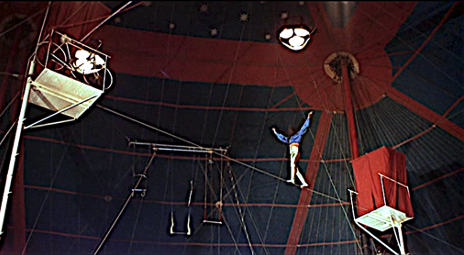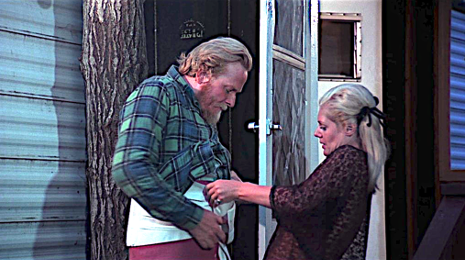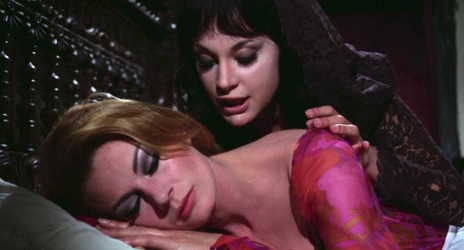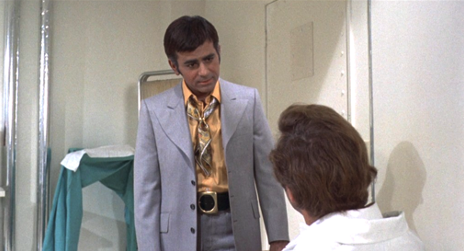Director: Jim O’Connolly
Writers: Herman Cohen, Aben Kandel
Producer: Herman Cohen
Cast: Joan Crawford, Ty Hardin, Judy Geeson, Diana Dors, Michael Gough, Robert Hardy, Geoffrey Keen, George Claydon, Philip Madoc, Sydney Taffler, Ambrosine Philpotts, Thomas Cimarro, Milton Reid, Ted Lune, Golda Casimir, Peter Burton, Marianne Stone, Miki Iveria, Howard Goorney, Reginald Marsh, Bryan Pringle
During a performance at The Great Rivers Circus in England, tightrope walker Gaspar the Great (Thomas Cimarro) is killed in a gruesome accident. As a result, circus attendance soars. The steel-willed co-owner and ringmistress of the circus, Monica Rivers (Joan Crawford), appreciates the increase in revenue that the morbid publicity generates. But as more deaths to circus personnel occur, suspicion and fear spread among the circus performers.
The Flashback Fanatic movie review
Once again the team of producer Herman Cohen and his writing partner, Aben Kandel, provide more thrills and chills in 1967’s Berserk. During the 1960s, American filmmaker Cohen’s productions had settled in England, but they were still punching the audience’s panic buttons. The horror Cohen is pitching this time around has a circus setting. Many circus acts serve to pad out the film’s running time and add a lot of production value to make this B film seem quite lavish. It is the Billy Smart Circus that provides many of the acts we see performed under the big top. Two other British-backed movies were also filmed in this famous venue: Circus of Horrors (1960) and Circus of Fear (1967).
Cohen’s Berserk provides even more spectacle with his chosen star: Joan Crawford. The Oscar-winning actress was entering the twilight of her career, but during the 1960s she had already appeared in a few successful shockers. In 1962’s What Ever Happened to Baby Jane?, Crawford co-starred with another aging Hollywood legend, Bette Davis. That hit film led to the “psycho-biddy” trend of thrillers starring older, established actresses usually playing against type. For horror-meister William Castle, Crawford starred in Straight-Jacket (1964) and I Saw What You Did (1965).
Supposedly, Joan Crawford’s clout prompted a title change for this film. Originally, it was called Circus of Blood, but Crawford suggested Berserk. That was certainly a memorable title that I’ll bet Crawford thought sounded a bit less exploitational. Her title would also keep this film from being confused with the previously made circus-based thrillers. What remains unknown is did Crawford suggest the title with or without an exclamation mark? The onscreen title has no punctuation, yet the posters for the film usually add an exclamation mark. Which is it?! It’s enough to drive this anal-retentive film fanatic berserk!
It seems that no matter what stage her career was at, or the intent of the material she was performing in, Joan Crawford always gave it her all. She did not think that headlining a lurid thriller made her any less of a star. In fact, Crawford quite rightly must have felt that her name was lending these productions a lot of prestige. She also thought that her fans must always perceive her as a star. Therefore, she had to give them a performance worthy of a star. In addition to her ballyhoo as the ringmistress announcing the acts and her take-charge demeanor with circus employees, Crawford deftly delivers a few saucy one-liners and subtle expressions that display her character’s worldly confidence.
Joan Crawford seems simpatico with her role in Berserk. Crawford was determined and relentless in achieving and maintaining her stardom. She channels that same resolve into her performance as the head of the circus that is the story’s setting. Her Monica Rivers is rather opportunistic about the bizarre death of her tightrope performer that has resulted in very profitable notoriety for her circus. Monica also demands that the show must go on, and it seems that her commanding presence is all that keeps the circus folk in line despite their paranoia. There are not a lot of shadings to her character or any others in this film, yet there is some ambiguity about them, which is appropriate in a mystery yarn.
For this horror fan, and a devotee of producer Herman Cohen’s flicks in particular, another name in this cast that gets my attention is Michael Gough. With Joan Crawford’s star power taking center stage, Gough is left with a supporting role instead of the villainous main attraction he had provided to distinguish Cohen’s previous Horrors of the Black Museum (1959), Konga (1961), and Black Zoo (1963). I find it quite interesting that Gough’s usual dominant and heartless role in a movie relationship is reversed in Berserk. Here his Albert Dorando is the subordinate and lovelorn business partner to Crawford’s Monica Rivers. Actor Gough performs an amusing about-face having the decency to criticize Crawford’s character for being cold-blooded about the tragedy that took the life of a circus performer. But fear not, Gough fans! The great Michael Gough’s vile villainy would be redeemed in the next Joan Crawford-starring Herman Cohen fright flick, Trog (1970).
Ty Hardin had starred as the hero on the ABC television network Western series Bronco (1959-62). Here Hardin plays hot-tempered Frank Hawkins, the handsome replacement for the deceased Gaspar the Great. Hawkins is suspect for not only conveniently showing up to replace the just-killed high-wire artist, he also is pretty deliberate about putting the moves on Monica Rivers. His proposition to become her business partner in the circus makes him appear up front about his ambitions, yet he still seems rather suspicious. While Hawkins acts frustrated with Monica’s reserve in their potential romance, we wonder if his urges are driven more by profit than passion.
The sexy standout in Berserk is Diana Dors. Once groomed to be the British alternative to Marilyn Monroe, Dors provides plenty of sparks to justify her blonde bombshell status. As Matilda, the assistant to the magician Lazlo (Philip Madoc), she is the circus sexpot and troublemaker. Whether she is trying to seduce the Magnificent Hawkins, badmouthing the magician she lives with, spreading malicious gossip, or getting into catfights, Matilda is probably my favorite character in Berserk. Any bodacious babe who drops by with notions of nookie in her noggin and brings her own booze is still a class act in my book.
Judy Geeson shows up as Angela Rivers, Monica’s just-booted-from-boarding school daughter. Angela’s reunion with her mother serves to soften the edges of the Monica Rivers character, making the hard-nosed circus owner a bit more sympathetic. This also seems to be following the Herman Cohen formula for having youthful characters prominent in his horror films.
Ultimately, Berserk is simply a showcase for Joan Crawford that kills time with circus acts and squabbles between the murders. Fully enjoying the film requires one to appreciate being part of that circus lifestyle for an hour and a half. I am all too happy to settle for this vicarious video experience. Although my immaturity means that I am never too old to consider running away to join the circus, unless I could land a sideshow gig as the Great Couch Potato, I would probably end up pounding tent stakes and shoveling up elephant droppings.

























































